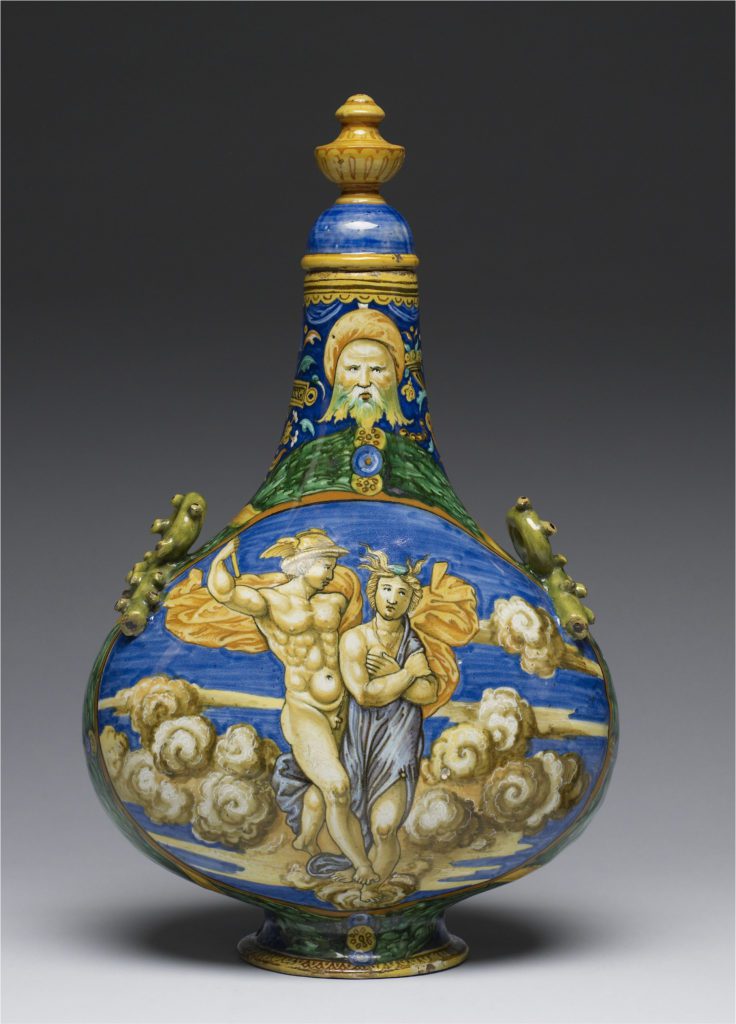‘Sharing Images’ at the National Gallery
By • June 6, 2018 0 302

Most museum exhibitions devoted to the art of the Italian and German Renaissance center around new and developing scholarship. The overwhelming majority of important works from this era are well documented and accounted for, and there are comparatively few lost, missing or destroyed bodies of work. To that end, those pieces that have been lost or destroyed are quite distinguished for their absence, and their histories and provenance are impressively thorough.
This is to say that, while Renaissance art exhibitions often teach us different ways to interpret works of art, rarely is there an opportunity to expose the audience to something completely new.
“Sharing Images: Renaissance Prints into Maiolica and Bronze,” on view through Aug. 5 at the National Gallery of Art, does not present new or never-before-seen works. However, what it does do is fascinating. Combining otherwise independent sets of well-known objects, it reveals a rarely explored history of imagery that injects new life into prominent prints and engravings by some of the most famous Renaissance artists, including Raphael, Michelangelo, Dürerand Mantegna.
It also manages to paint a full historical picture using only objects. There is, of course, wall text, but “Sharing Images” is one of those rare historical exhibitions in which the art itself gives the audience everything that is needed — a narrative magic unique to museums. Both the scholarship and the layout are a testament to the taste and expertise of curator Jamie Gabbarelli, whose accompanying catalog is rife with anecdotal and historical interest.
Inspired by the gallery’s acquisition of a maiolica (Italian tin-glazed pottery) collection from the Corcoran Gallery of Art, “Sharing Images” tells the story of how printed images were transmitted, transformed and translated onto ceramics and small bronze reliefs during the 15th century.
It begins, as with most of contemporary civilization, with the development of the printing press. With the appearance and diffusion of prints in the 15th century, the way Europeans produced, shared and exploited images underwent a rapid and radical change. For the first time, artists could swiftly reproduce complex designs in multiple copies with relatively little effort, permanently transforming the contents, appearance and function of art for the next four centuries.
Their small size and light material meant that prints could easily move across long distances, while their existence as multiples made them affordable and improved their chances of survival over time. Crossing territorial and cultural boundaries, prints broadcast visual motifs, compositions, subjects and styles with unprecedented speed, intensifying artistic exchanges across the continent.
By the early 16th century, most Italian artists were well acquainted with the radically innovative engravings executed in Germany by Dürer, while Dürer himself knew and copied 15th-century Italian prints.
On a greater scale than ever before, prints created a common visual culture for an expanding European audience.However, the way ceramic artists and bronze engravers across Italy interpreted these master prints onto plates and plaques is both revealing and dizzyingly amusing. While their production helps answer some crucial questions — such as how rapidly certain prints circulated and which were widely known or especially popular — they are also simply a joy to behold and compare with the printed originals.
Looking at the higher end of quality, a large dish after Marco Dente’s c. 1520 “Battle Scene” engraving is an elaborate tapestry of fiery orange-yellow horses and rich blue ripples of water, sky and armor. The vitality and energy of the painted ceramic copy has a levity and an off-kilter exuberance. Dente would surely have been mortified to see this bastardized version of his grim and valorous depiction of warfare. Nevertheless, the platter is inarguably successful — captivating, full of life and a terrific slice of history.
Then there are pieces like a flask depicting Mercury and Psyche, after a print originally by Raphael. It has the same charm as the “Battle Scene” platter, but in its effort to convey tenderness and delicacy in its subject there is an unavoidable technical clunkiness, concealed far more easily in a noisy depiction of warfare.
One thing “Sharing Images” shows us is that the Renaissance was also a sort of innovator in kitsch. In much the same way that the Abstract Expressionist market survives today through fine art prints, knock-off reproductions, “flung-paint” ceramic ware and local copycat artists of wildly varying quality, these maiolica and bronze reliefs exhibit a range of quality and refinement — including the low end — that typically goes unmentioned when discussing the great rebirth of Western civilization.
There are obvious reasons for this. Cream rises to the top. It is logical that only the finest specimens of any era would remain in the cultural consciousness over the passage of so much time. There just isn’t that much room in our collective memory to account for the full hierarchical spectrum of art of a given era without editing for quality control.
But a show like this serves as an absorbing reminder: Where there is creative genius, there is always a spore-like ecosystem of opportunists, ready to capitalize on it in every way possible.
I loved this show. It is an exhibition for the museum darlings among us. Explore the galleries, entrench yourself in the divine master prints and the ancient ceramic kitsch and fall in love with the Renaissance all over again.

